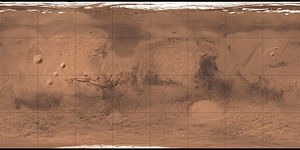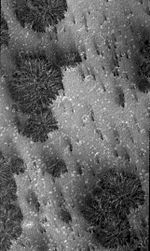Planum Australe
| Plane on mars | ||
|---|---|---|
| Planum Australe | ||

|
||
| Planum Australe as photographed by Mars Global Surveyor . | ||
|
|
||
| position | 84 ° S , 160 ° E | |
| expansion | 1600 km | |
| history | ||
| Eponym | Latin for the southern plain | |
The planum Australe ( Latin for 'the southern plain') is the plains area of the southern Mars pole . It stretches from about 75 degrees southwards and has a length of 1600 km and a width of about 1200 km. Its center is at 83.9 ° S and 160.0 ° E. The geology of this region was originally intended to be investigated by NASA's Mars Polar Lander mission , but this failed because contact with the probe was lost when it entered the Martian atmosphere .
Ice sheet
The Planum Australe is partially covered by a permanent, approximately 3 km thick, polar ice cap made of frozen water and carbon dioxide . During the Martian winter, a seasonal ice cap also forms on this permanent ice cap, which extends from 60 ° S to the south. At the height of winter, this reaches a thickness of about one meter. It is possible that the area of this ice cap will temporarily shrink due to local climate changes , but then expand again.
In 1966, the scientists Leighton and Murray suggested that the polar caps of Mars could represent a storage facility for CO 2 , the capacity of which might be considerably larger than the atmospheric reservoir. However, it is now assumed that both poles consist mainly of water ice and are only covered with a thin blanket of seasonal CO 2 . The southern pole retains a permanent remnant of its CO 2 blanket, which is around 8 to 10 meters thick and rests on a foundation made of water ice. The assumption that most of the ice must consist of water arises from the fact that CO 2 ice is not mechanically strong enough to be able to hold a 3 km thick ice sheet stable over long periods of time.
The data of the probe Mars Express the ESA show that the ice cap substantially in three sections of different ice conditions can be differentiated. The most reflective part of the ice cap is about 85% dry ice and 15% water ice. The second section, where the ice cover forms steep slopes on the border with the surrounding plain, consists almost entirely of water ice. Finally , the ice cap is also surrounded by permafrost fields that extend northward for dozens of kilometers away from the steep slopes .
The center of the permanent ice cap is not at 90 ° S, but about 150 kilometers north of the geographic South Pole. The presence of two massive impact basins in the western hemisphere - Hellas Planitia and Argyre Planitia - create an immobile area of deeper pressure above the permanent ice cap. The resulting weather patterns lead to the formation of soft, white snow , which has a high albedo . This is in contrast to the black ice that defines the eastern part, where little snow falls.
Characteristics
General characteristics
The Planum Australe basically consists of two areas - the Australe Lingula (recognizable on the relief map as the upper foothill) and the Promethei Lingula (seen on the map as the foothill shown in the center on the right, which is bordered by canyons from above and below ). Both sections are traversed by ravines called Promethei Chasma , Ultimum Chasma , Chasma Australe and Australe Sulci . It can be assumed that these canyons were formed by catabatic winds . The largest crater in Planum Australe is the 20 kilometer wide McMurdo Crater at −84.5 ° S and 0.9 ° E at the (in the elevation top) edge of the plain.
Geysers on Mars
On images taken by the Mars Global Surveyor space probe, some dark spots were discovered in the dune fields of the southern polar region, which appear and then appear to disappear again with the change of the seasons. Some scientists explain this phenomenon, known as Dark Dune Spots , to the seasonal freezing and thawing of the southern ice cap, which leads to the formation of spider-like radial channels that are formed in the one-meter-thick ice by sunlight.
A group of researchers, led by Hugh Kieffer, of the United States Geological Survey in Flagstaff, Arizona, suggests that the stains and other inexplicable properties are caused by violent jets of carbon dioxide gas that break through the overlying layer of frozen CO 2 and erupt in fountains up to 100 meters high. The sublimation of the CO 2 - and possibly also of the water - increases the pressure inside the ice cover, which could lead to geyser-like outbreaks of cold liquid, often in connection with dark basalt, sand or mud. This process is rapid and can last for a few days, weeks, or months, an unusually long period in geology. The fact is, these spots often appear to appear over a spider-like furrow pattern seen in photos from the south polar region of Mars. A more detailed exploration of this region is not planned in the current planning.
Web links
- Accumulation and erosion of south polar layered deposits in the Promethei Lingula region, Planum Australe, Mars
- Stratigraphic and topographic map of the McMurdo crater area, Planum Australe, Mars (PDF; 199 kB)
- Topographic map of the Martian South Pole
- USGS map of the Planum Australe
Individual evidence
- ↑ Planum Australe in the Gazetteer of Planetary Nomenclature of the IAU (WGPSN) / USGS
- ↑ Ken Herkenhoff: Geologic Map of the MTM -85280 Quadrangle, Planum Australe Region of Mars (PDF) ( English , PDF; 435 kB) California Institute of Technology. 1994. Archived from the original on May 28, 2010. Info: The archive link was automatically inserted and has not yet been checked. Please check the original and archive link according to the instructions and then remove this notice. Retrieved March 27, 2010.
- ↑ NASA - Mars is Melting. In: nasa.gov. Retrieved September 26, 2017 (English).
- ↑ Steinn Sigurdsson: Global warming on Mars? . RealClimate.org. Retrieved October 20, 2006.
- ↑ Shane Byrne: A Sublimation Model for Martian South Polar Ice Features . In: Science . 299, February 14, 2003, pp. 1051-1053. doi : 10.1126 / science.1080148 .
- ^ Water at Martian south pole . European Space Agency . Retrieved October 22, 2006.
- ↑ Mars' South Pole mystery . Spaceflight Now. Retrieved October 26, 2006.
- ↑ Eric J. Kolb, Kenneth L. Tanaka: Accumulation and Erosion of the South Pole in the Promethei Lingula Region, Australe Planum, Mars . In: Mars Informatics Inc. (Ed.): The Mars Journal . 2, 2006, pp. 1-9. doi : 10.1555 / mars.2006.0001 .
- ↑ NASA Findings Suggest Jets Bursting From Martian Ice Cap (English) . In: Jet Propulsion Laboratory , NASA, August 16, 2006. Retrieved August 11, 2009.
- ^ Hugh H. Kieffer: Mars Polar Science 2000 . (PDF) In: ANNUAL PUNCTUATED CO2 SLAB-ICE AND JETS ON MARS. . 2000.
- ↑ G. Portyankina: Fourth Mars Polar Science Conference . (PDF) In: SIMULATIONS OF GEYSER-TYPE ERUPTIONS IN CRYPTIC REGION OF MARTIAN SOUTH . 2006.
- ^ Hugh H. Kieffer, Philip R. Christensen, Timothy N. Titus: CO2 jets formed by sublimation beneath translucent slab ice in Mars' seasonal south polar ice cap . In: Nature . 442, May 30, 2006, pp. 793-796. doi : 10.1038 / nature04945 .
- ↑ Gas fountains on Mars . August 16, 2006. Retrieved March 29, 2010.



